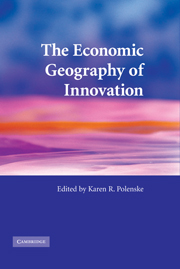Book contents
- Frontmatter
- Contents
- List of figures
- List of tables
- Notes on contributors
- Acknowledgments
- Abstracts
- List of abbreviations and acronyms
- Part I Concepts and measurements in innovation
- 1 Introduction
- 2 Measurement of the clustering and dispersion of innovation
- 3 Measuring the geography of innovation: a literature review
- 4 Employment growth and clusters dynamics of creative industries in Great Britain
- Part II Institutional and spatial aspects of information and knowledge flows
- Part III Institutions and innovation systems
- Index
- References
2 - Measurement of the clustering and dispersion of innovation
Published online by Cambridge University Press: 22 September 2009
- Frontmatter
- Contents
- List of figures
- List of tables
- Notes on contributors
- Acknowledgments
- Abstracts
- List of abbreviations and acronyms
- Part I Concepts and measurements in innovation
- 1 Introduction
- 2 Measurement of the clustering and dispersion of innovation
- 3 Measuring the geography of innovation: a literature review
- 4 Employment growth and clusters dynamics of creative industries in Great Britain
- Part II Institutional and spatial aspects of information and knowledge flows
- Part III Institutions and innovation systems
- Index
- References
Summary
Introduction
The chapters in this volume deal with the interplay of two characteristic features of today's global economy: rapid technological change and shifts in the loci of economic activity. As might be expected, no two authors interpret the terms “location” and “innovation” identically. Both domains are very broad and complex and authors single out particular facets for separate study. It is striking that most of them focus on research and the creation, acquisition, and sharing of knowledge, rather than dealing directly with changes in the production process and in the kinds of products on the market. Perhaps this should be taken as a reminder that we have indeed entered the era of the “knowledge economy.”
Economists might see this emphasis on information and communication as a focus on the first of Schumpeter's three major phases of technological change, namely invention. Seeing technological change as the primary focus of capitalism, Schumpeter draws sharp distinctions among invention, creating the idea behind a change in the production process; innovation, implementing that idea in the market environment for the first time; and diffusion, the spread of implementation to sites beyond the original one.
Schumpeter saw the innovator as the visionary and the primary risktaker in the chain of individuals responsible for technological change (Schumpeter 1926). His inventor was an inspired individual with a new idea, but was not an economic actor. Today, invention is likely to be purposive economic activity involving significant investment and risk.
- Type
- Chapter
- Information
- The Economic Geography of Innovation , pp. 13 - 29Publisher: Cambridge University PressPrint publication year: 2007
References
- 2
- Cited by

